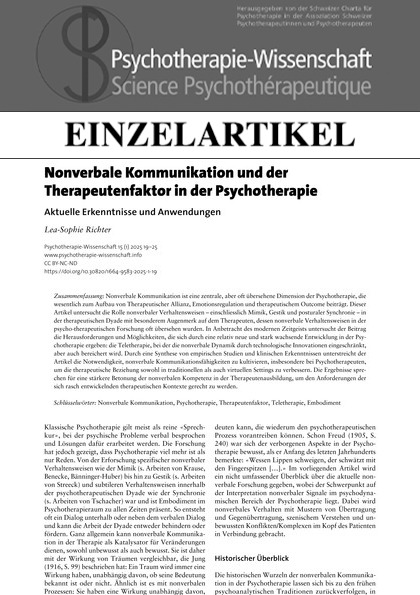Non-verbal communication and the therapist factor in psychotherapy
Current findings and applications
DOI:
https://doi.org/10.30820/1664-9583-2025-1-19Keywords:
nonverbal communication, psychotherapy, therapist factor, teletherapy, embodimentAbstract
Nonverbal communication is a crucial yet often overlooked dimension of psychotherapy, contributing significantly to alliance building, emotional regulation, and therapeutic outcomes. This article explores the role of nonverbal behaviors – including facial expressions, gestures, and postural synchrony – in the therapeutic dyad with a special emphasis on the therapist, whose nonverbal behaviors have often not been considered in psychotherapeutic research. Given the modern Zeitgeist the paper examines challenges and opportunities posed by a rather new and vastly growing development in psychotherapy: teletherapy, where nonverbal dynamics are limited yet also enriched by technological innovations. Through a synthesis of empirical studies and clinical insights, the article underscores the necessity of fostering nonverbal communication skills; – especially in the psychotherapy practitioners – to strengthen the therapeutic relationship in both traditional and virtual settings. The findings advocate for greater emphasis on nonverbal competencies in psychotherapy training to meet the demands of fast evolving therapeutic contexts.
Downloads
How to Cite
Richter, L.-S. (2025). Non-verbal communication and the therapist factor in psychotherapy: Current findings and applications. Psychotherapie-Wissenschaft, 15(1), 19–25. https://doi.org/10.30820/1664-9583-2025-1-19
Issue
Section
Special Issue
License

This work is licensed under a Creative Commons Attribution-NonCommercial-NoDerivatives 3.0 Unported License.
This journal provides open access to its content in accordance with the basic premise that the free public availability of research benefits the exchange of knowledge throughout the world.
Authors wishing to publish in this journal agree to the following:
- The author/s retain/s the copyrights and consent/s to initial publication of the work in the journal under a Creative Commons Attribution licence, which allows third parties to use the work by citing the name/s of the author/s and this journal as initial publisher (in accordance with the Creative Commons Attribution-NonCommercial-NoDerivs 3.0 DE-Licence).
- The author/s can enter into additional contracts for the non-exclusive distribution (e.g. publish in a collection or book) of the version published in the journal, if the journal is cited as initial publisher.


